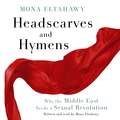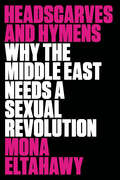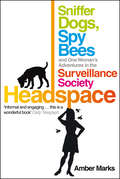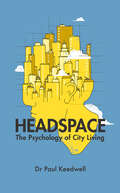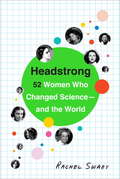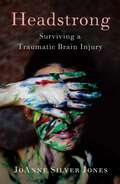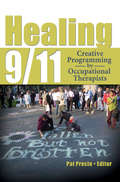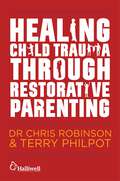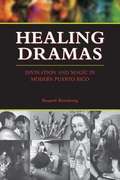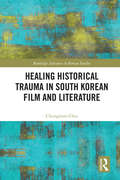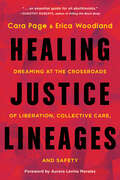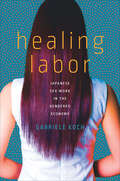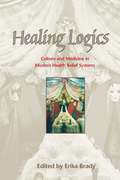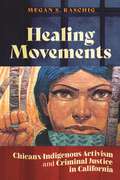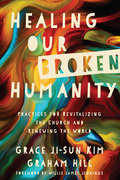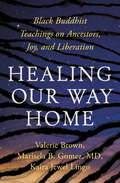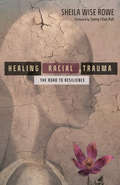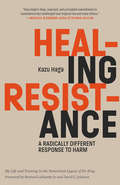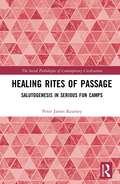- Table View
- List View
Headscarves and Hymens: Why the Middle East Needs a Sexual Revolution
by Mona EltahawyWritten and read by the author.In November 2011, Mona Eltahawy came to worldwide attention when she was assaulted by police during the Egyptian Revolution. She responded by writing a groundbreaking piece in FOREIGN POLICY entitled 'Why Do They Hate Us?'; 'They' being Muslim men, 'Us' being women. It sparked huge controversy. In HEADSCARVES AND HYMENS, Eltahawy takes her argument further. Drawing on her years as a campaigner and commentator on women's issues in the Middle East, she explains that since the Arab Spring began, women in the Arab world have had two revolutions to undertake: one fought with men against oppressive regimes, and another fought against an entire political and economic system that treats women as second-class citizens in countries from Yemen and Saudi Arabia to Egypt, Tunisia, and Libya.Eltahawy has travelled across the Middle East and North Africa, meeting with women and listening to their stories. Her book is a plea for outrage and action on their behalf, confronting the 'toxic mix of culture and religion that few seem willing or able to disentangle lest they blaspheme or offend.' A manifesto motivated by hope and fury in equal measure, HEADSCARVES AND HYMENS is as illuminating as it is incendiary.(p) 2015 Macmillan Audio
Headscarves and Hymens: Why the Middle East Needs a Sexual Revolution
by Mona EltahawyA passionate manifesto decrying misogyny in the Arab world, by an Egyptian American journalist and activistWhen the Egyptian journalist Mona Eltahawy published an article in Foreign Policy magazine in 2012 titled "Why Do They Hate Us?" it provoked a firestorm of controversy. The response it generated, with more than four thousand posts on the website, broke all records for the magazine, prompted dozens of follow-up interviews on radio and television, and made it clear that misogyny in the Arab world is an explosive issue, one that engages and often enrages the public. In Headscarves and Hymens, Eltahawy takes her argument further. Drawing on her years as a campaigner and commentator on women's issues in the Middle East, she explains that since the Arab Spring began, women in the Arab world have had two revolutions to undertake: one fought with men against oppressive regimes, and another fought against an entire political and economic system that treats women in countries from Yemen and Saudi Arabia to Egypt, Tunisia, and Libya as second-class citizens. Eltahawy has traveled across the Middle East and North Africa, meeting with women and listening to their stories. Her book is a plea for outrage and action on their behalf, confronting the "toxic mix of culture and religion that few seem willing or able to disentangle lest they blaspheme or offend." A manifesto motivated by hope and fury in equal measure, Headscarves and Hymens is as illuminating as it is incendiary.
Headspace: Sniffer Dogs, Spy Bees and One Woman's Adventures in the Surveillance Society
by Amber MarksCrime detection has gone to the dogs and squirrels are being busted for espionage. If you've never wondered about the new direction of 'intelligence-led policing' in our society, now is the time to start. It was a chance encounter with a police sniffer-dog that drew criminal lawyer Amber Marks into the hidden world of the science of smell and its law-enforcement applications. Soon she stumbled into a wonderland of contemporary surveillance, where the spying skills of bees, dolphins and a myriad other critters were being harnessed to build a 'secure world' of bio-intelligence. From the businesses, scientists and military departments developing new smell-based surveillance technologies, to good old-fashioned police dogs, Amber discovered a secret world of security forces, where animals and scent are as important as intelligence agents and CCTV.Part polemical exploration of our burgeoning surveillance society, part humorous memoir, this intriguing book will capture your imagination and get you wondering: just who stands to benefit from all this 'security'?
Headspace: The Psychology of City Living
by Dr. Paul KeedwellAn examination of the secret psychology of the city and how it affects our daily happiness. More and more of us are choosing to live in the man-made environment of the city. The mismatch between this artificial world and our nature-starved souls can contribute to the stresses of city living in a way that is barely noticed—but is crucially important.What does the science of architectural psychology tell us about how the world of brick and concrete affects how we think, feel and behave?In an increasingly crowded urban world, how does good urban design inspire, restore and bring us together?Conversely, how does bad architecture cause anxiety, alienation and depression?Starting with the home and reaching out to the street, neighbourhood and wider city landscape, Headspace teaches us how to see our cities differently, and how we can best adapt to our rapidly changing urban world.Praise for Headspace“Full of interesting nuggets. Presents the results of scores of scientific studies into the physical environment and does so in a pleasant, discursive way.” —Will Wiles, RIBA Journal“A properly glorious book. Amazing.” —Monocle Radio“Links what we build with what we do. It’s an important question—an architectural holy grail, in a way.” —Evening Standard
Headstrong: 52 Women Who Changed Science-and the World
by Rachel SwabyFifty-two inspiring and insightful profiles of history's brightest female scientists. In 2013, the New York Times published an obituary for Yvonne Brill. It began: "She made a mean beef stroganoff, followed her husband from job to job, and took eight years off from work to raise three children." It wasn't until the second paragraph that readers discovered why the Times had devoted several hundred words to her life: Brill was a brilliant rocket scientist who invented a propulsion system to keep communications satellites in orbit, and had recently been awarded the National Medal of Technology and Innovation. Among the questions the obituary--and consequent outcry--prompted were, Who are the role models for today's female scientists, and where can we find the stories that cast them in their true light? Headstrong delivers a powerful, global, and engaging response. Covering Nobel Prize winners and major innovators, as well as lesser-known but hugely significant scientists who influence our every day, Rachel Swaby's vibrant profiles span centuries of courageous thinkers and illustrate how each one's ideas developed, from their first moment of scientific engagement through the research and discovery for which they're best known. This fascinating tour reveals these 52 women at their best--while encouraging and inspiring a new generation of girls to put on their lab coats.From the Trade Paperback edition.
Headstrong: Surviving a Traumatic Brain Injury
by JoAnne Silver JonesShe didn&’t see the hammer. For a fraction of a second JoAnne Jones saw a young black face, framed by a black hoodie, and then she descended into a place where she felt and saw nothing. Jones survived this sudden assault by a stranger, but it left her with severe traumatic brain injury (TBI), fractured hands, and PTSD. Headstrong tells the story of how she learned to live with the daily challenges of TBI. It brings the reader into a life traumatized by violence and set in the context of a society full of violence and vocal, visible white supremacists. Woven throughout Jones&’s account are the stories of how medical professionals, friends, family, and strangers became a foundation strong enough to hold her during the worst of times, and to give her the buoyancy to find a path toward hope.
Heal Yourself!
by Mark James Estren Beverly A. PotterDoctors think they heal with drugs. But only living cells can heal. When something is out of balance, your cells move to correct it because bodies want to be well. HEAL YOURSELF! HOW TO HARNESS PLACEBO POWER shows how to tap into this mysterious process to get well and stay well by harnessing your body's natural healing power-the power of placebo.These amazing effects are not just "in the mind." They can be observed and measured in the body's physiology. When patients believe in the treatment, ulcers heal, warts disappear, cancer goes into remission, swelling reduces-cells actually look different under the microscope. When your doctor believes in the treatment, the impact is even more powerful -not in every case, of course. But in enough that science now accepts that something is going on!HEAL YOURSELF! explains how researchers believe that the stress response creates an environment that promotes physiological breakdown, while the relaxation Response creates a healing environment. HEAL YOURSELF! offers specific things you can do, and do today, to turn on your body's innate healing mechanisms, including meditation, prayer, laughter, listening to music and rocking, Qi Gong, gratitude and forgiveness, and more.healing mechanisms.
Healing 9/11: Creative Programming by Occupational Therapists
by Pat PrecinGet a first-hand look at the ongoing tragedy of 9/11 Healing 9/11 examines programs and interventions created and implemented by occupational therapists to aid those affected directly-and indirectly-by the 9/11 attacks. Ideal for courses in trauma and recovery, community interventions, disaster recovery, health programs and implementation, and mental health interventions as well as for professionals, this powerful book chronicles the experiences of OTs who worked with firefighters, burn victims, and displaced workers, as well as children, students, and clients suffering long-term symptoms of depression and anxiety. These first-hand accounts offer rare insights into the healing process for victims of terrorism (including OTs themselves), and serve as a guide to developing outreach and counseling services to those touched by future incidents. Healing 9/11 continues the work of Surviving 9/11: Impact and Experiences of Occupational Therapy Practitioners (Haworth), presenting detailed personal and professional accounts from OTs who provided physical, emotional, and psychosocial relief to thousands of disaster victims. This unique book reveals how OTs provided aggressive manual therapy, wound care, and scar management to the critically injured; how OTs analyzed the job market and found work for people who had lost their livelihoods; how OTs worked with students in classroom settings to relieve their anxieties; and how OTs helped rescue workers at Ground Zero deal with the emotions that threatened to overpower them.Healing 9/11 examines: nontraditional group therapy non-clinical treatment settings burn rehabilitation pediatric occupational therapy school-based occupational therapy employment planning occupational frame of reference creative arts therapy post traumatic stress disorder and much more Healing 911: Creative Programming by Occupational Therapists is an essential resource for all healthcare professionals who offer relief in times of disaster.
Healing Child Trauma Through Restorative Parenting: A Model for Supporting Children and Young People
by Chris Robinson Terry Philpot Karen Mitchell-Mellor Andrew ConstableHow can we help heal children who have been abused or neglected? Healing Child Trauma Through Restorative Parenting details how children can be helped to recover with the use of Restorative Parenting, an innovative model informed by psychological and neurological understanding of trauma and its effects. It explains the critical role that people, relationships and the environment play in a child's recovery. It shows what constitutes a therapeutic environment, whereby a child experiences therapy not as one-to-one sessions but as a lived experience. The authors show how other components of the model - building therapeutic relationships, promoting positive education and encouraging clinically informed life style choices - are intimately linked, each critical to the re-parenting which the child undergoes. This book will be welcomed by professionals working with children, including those in residential, health and foster care, psychology, education and health, as well as those commissioning services. The models, concepts and practices are transferable to public, private and charitable agencies.
Healing Dramas: Divination and Magic in Modern Puerto Rico
by Raquel RombergIn this intimate ethnography, Raquel Romberg seeks to illuminate the performative significance of healing rituals and magic works, their embodied nature, and their effectiveness in transforming the states of participants by focusing on the visible, albeit mostly obscure, ways in which healing and magic rituals proceed. The questions posed by Romberg emerge directly from the particular pragmatics of Puerto Rican brujería (witch-healing), shaped by the eclecticism of its rituals, the heterogeneous character of its participants, and the heterodoxy of its moral economy. What, if any, is the role of belief in magic and healing rituals? How do past discourses on possession enter into the performative experience of ritual in the here and now? Where does belief stop, and where do memories of the flesh begin? While these are questions that philosophers and anthropologists of religion ponder, they acquire a different meaning when asked from an ethnographic perspective. Written in an evocative, empathetic style, with theoretical ruminations about performance, the senses, and imagination woven into stories that highlight the drama and humanity of consultations, this book is an important contribution to the cross-cultural understanding of our capacity to experience the transcendental in corporeal ways.
Healing Elements
by Sienna R. CraigTibetan medicine has come to represent multiple and sometimes conflicting agendas. On the one hand it must retain a sense of cultural authenticity and a connection to Tibetan Buddhism; on the other it must prove efficacious and safe according to biomedical standards. Recently, Tibetan medicine has found a place within the multibillion-dollar market for complementary, traditional, and herbal medicines as people around the world seek alternative paths to wellness. Healing Elements explores how Tibetan medicine circulates through diverse settings in Nepal, China, and beyond as commercial goods and gifts, and as target therapies and panacea for biophysical and psychosocial ills. Through an exploration of efficacy - what does it mean to say Tibetan medicine "works"? - this book illustrates a bio-politics of traditional medicine and the meaningful, if contested, translations of science and healing that occur across distinct social ecologies.
Healing Herbal Soups: Boost Your Immunity and Weather the Seasons with Traditional Chinese Recipes: A Cookbook
by Rose Cheung Genevieve WongSoothe your soul and boost your immunity with these easy and delicious soup recipes that incorporate Traditional Chinese Medicine. Combining the trends of culinary medicine and seasonal eating and adding a dash of Traditional Chinese Medicine (TCM), Healing Herbal Soups is the first book of its kind to focus on boosting immunity and weathering the seasons, by a mother-daughter, Chinese-American duo. Rose and Genevieve have been making Chinese herbal soups in their kitchens all their lives. They made broths to help their bodies adapt to the seasons, and now, for the first time, they&’re translating these traditional recipes—all of which have been vetted by Dr. Shiu Hon Chui, a preeminent TCM doctor, researcher, and professor—into English. Healing Herbal Soups provides a complete herbal encyclopedia and more than fifty tasty recipes—with full-color photographs—that mix herbs with meat and vegetables to create healing broths. These easy-to-follow recipes are here for you whenever you feel unwell, or if you&’re just looking to add healthy soups to your weekly meal rotation. Armed with an introduction to TCM and special sections on tea, ginger, and ginseng, as well, at last, you can feel less dependent on Western concoctions of drugs and chemicals, and start using traditional Chinese herbs right in the comfort of your own home.
Healing Historical Trauma in South Korean Film and Literature (Routledge Advances in Korean Studies)
by Chungmoo ChoiThrough South Korean filmic and literary texts, this book explores affect and ethics in the healing of historical trauma, as alternatives to the measures of transitional justice in want of national unity. Historians and legal practitioners who deal with transitional justice agree that the relationship between historiography and justice seeking is contested: this book reckons with this question of how much truth-telling from a violent past will lead to healing, forgiving, forgetting and finally overcoming resentment. Nuanced interpretations of South Korean filmic and literary texts are featured, including Park Chan-wook’s Oldboy, Bong Joon-ho’s Mother and literary texts of Han Kang and Ch’oe Yun, whilst also engaging the ethical and political philosophy of Levinas, Hannah Arendt, and others. Also offered is new and extensive research into the hitherto hidden history of thousands of North Korean war orphans who were sent to Eastern European countries for care. Grappling with the evils of history, the films and novels examined herein find their ultimate themes in compassion, hospitality, humility and solidarity of the wounded. Healing Historical Trauma in South Korean Film and Literature will appeal to students and scholars of film, comparative literature, cultural studies and Korean studies more broadly.
Healing Home
by Vanessa OliverBased on research that was awarded the Governor General's Academic Gold Medal, Healing Home is an exploration of the lives and health of young women experiencing homelessness. Vanessa Oliver employs an innovative methodology that blends sociology and storytelling practices to investigate these women's access to health services, their understandings of health and health care delivery, and their health-seeking behaviours. Through their life stories, Oliver demonstrates how personal and social experiences shape health outcomes.In contrast to many previous studies that have focused on the deficits of these young people, Healing Home is both youth-centric and youth-positive in its approach: by foregrounding the narratives of the women themselves, Oliver empowers a sub-section of the population that traditionally has not had a voice in determining policies that shape their realities. Applying a strong, articulate, and systemic analysis to on-the-ground narratives, Oliver is able to offer fresh, incisive recommendations for health and social service providers with the potential to effect real-world change for this marginalized population.
Healing Hormones
by Mark James Estren Beverly A. PotterHealing Hormones tackles a huge, attention-getting subject. TV and radio shows, websites telling people to take it easy, slow down, de-stress to feel better, live longer, be a better parent and more loving mate. But how? The prescriptions are disappointing: Yoga? Time-consuming and difficult for many. Prescription drugs? Costly, subject to abuse and may not be helpful. Naturopathic remedies? Unproven, untested and often ineffective.Healing Hormones has a better answer: show readers how to harness their own bodies' heal producing chemicals to improve their lives. Healing Hormones takes the take-care-of-yourself trend a step beyond where it has been before. Author Mark J. Estren, Ph.D., investigates five body-produced hormones that counter the stress response to make life better, calmer and more relaxed. The five healing hormones are dopamine, nitric oxide, endorphins, oxytocin, and serotonin.Healing Hormones will be readers' top choice to learn the pluses and minuses of the remarkable hormones that drive their health and happiness or undercut it. Estren-who has more than 20 years of experience writing about medical issues and research for patients and their families-explains how to harness the power of these healing hormones in clear, easily understandable language.
Healing Justice Lineages: Dreaming at the Crossroads of Liberation, Collective Care, and Safety
by Cara Page Erica WoodlandA profound offering and call to action—collective stories, testimonials, and incantations for renewing political and spiritual liberation grounded in Black, Indigenous, People of Color, and Queer and Trans healing justice lineages <p><p>We reclaim the power, resilience, and innovation of our ancestors through this book. To embody their wisdom across centuries and generations is to continue their legacy of liberation and healing. <p><p>In this anthology, Black Queer Feminist editors Cara Page and Erica Woodland guide readers through the history, legacies, and liberatory practices of healing justice—a political strategy of collective care and safety that intervenes on generational trauma from systemic violence and oppression. They call forth the ancestral medicines and healing practices that have sustained communities who have survived genocide and oppression, while radically imagining what comes next. <p><p>Anti-capitalist, Black feminist, and abolitionist, Healing Justice Lineages is a profound and urgent call to embrace community and survivor-led care strategies as models that push beyond commodified self-care, the policing of the medical industrial complex, and the surveillance of the public health system. Centering disability, reproductive, environmental, and transformative justice and harm reduction, this collection elevates and archives an ongoing tradition of liberation and survival—one that has been largely left out of our history books, but continues to this day. <p><p>In the first section, “Past: Reckoning with Roots and Lineage,” Page and Woodland remember and reclaim generations-long healing justice and community care work, asking critical questions like: How did our ancestors transform trauma and violence in their liberation work? What were our ancestors reckoning with—and what did they imagine? <p><p>The next sections, “Origins of Healing Justice” and “Alchemy: Theory + Praxis,” explore regional stories of healing justice in response to the current political and cultural landscape. The last section, “Political + Spiritual Imperatives for the Future,” imagines a future rooted in lessons of the past; addresses the ways healing justice is being co-opted and commodified; and uplifts emergent work that’s building infrastructure for care, safety, healing, and political liberation.
Healing Labor: Japanese Sex Work in the Gendered Economy
by Gabriele KochContemporary Japan is home to one of the world's largest and most diversified markets for sex. Widely understood to be socially necessary, the sex industry operates and recruits openly, staffed by a diverse group of women who are attracted by its high pay and the promise of autonomy—but whose work remains stigmatized and unmentionable. Based on fieldwork with adult Japanese women in Tokyo's sex industry, Healing Labor explores the relationship between how sex workers think about what sex is and what it does and the political-economic roles and possibilities that they imagine for themselves. Gabriele Koch reveals how Japanese sex workers regard sex as a deeply feminized care—a healing labor—that is both necessary and significant for the well-being and productivity of men. In this nuanced ethnography that approaches sex as a social practice with political and economic effects, Koch compellingly illustrates the linkages between women's work, sex, and the gendered economy.
Healing Logics: Culture and Medicine in Modern Health Belief Systems
by Erika BradyScholars in folklore and anthropology are more directly involved in various aspects of medicine—such as medical education, clinical pastoral care, and negotiation of transcultural issues—than ever before. Old models of investigation that artificially isolated "folk medicine," "complementary and alternative medicine," and "biomedicine" as mutually exclusive have proven too limited in exploring the real-life complexities of health belief systems as they observably exist and are applied by contemporary Americans. Recent research strongly suggests that individuals construct their health belief systmes from diverse sources of authority, including community and ethnic tradition, education, spiritual beliefs, personal experience, the influence of popular media, and perception of the goals and means of formal medicine. Healing Logics explores the diversity of these belief systems and how they interact—in competing, conflicting, and sometimes remarkably congruent ways. This book contains essays by leading scholars in the field and a comprehensive bibliography of folklore and medicine.
Healing Movements: Chicanx-Indigenous Activism and Criminal Justice in California
by Megan S. RaschigHow a grassroots abolitionist project of cultural healing counters the carceral state in a Chicanx community in CaliforniaFor many, gang involvement can be a guaranteed life sentence, a force which traps them in an inescapable cycle of violence even if it does not lead to actual prison time. Healing Movements explores the work of formerly gang-involved Chicanx men and women in California who draw on the social connections made during their gang-involved years to forge new pathways for cultural healing and countering the carceral system.Known colloquially as the “movement of healing,” this Chicanx-Indigenous abolitionist project based in Salinas, California, was spurred on by a series of four police homicides of Latino men in 2014. Organizing around such issues as police brutality and mass incarceration, these collectives—two of which are discussed in this book, one mixed-gender, and the other women-only—turned to their often obscured Mesoamerican ancestry to find new resources for building a different future for themselves and subsequent generations.Drawing on extensive fieldwork conducted in Salinas, Healing Movements reveals how these communities have taken shape in large part through a conscious effort to uplift Chicanx-Indigenous culture and ceremonial practices. By tapping into their Indigeneity, the members of these collectives access a wealth of new resources to shape their future, opening up novel ways to organize and build strong relational ties that are noteworthy to anyone invested in abolitionist work.
Healing Our Broken Humanity: Practices for Revitalizing the Church and Renewing the World
by Graham Hill Willie James Jennings Grace Ji-Sun KimWe live in conflicted times. Our newsfeeds are filled with inequality, division, and fear. We want to make a difference and see justice restored because Jesus calls us to be a peacemaking and reconciling people. But how do we do this? Based on their work with diverse churches, colleges, and other organizations, Grace Ji-Sun Kim and Graham Hill offer Christian practices that can bring healing and hope to a broken world. They provide ten ways to transform society, from lament and repentance to relinquishing power, reinforcing agency, and more. Embodying these practices enables us to be the new humanity in Jesus Christ, so the church and world can experience reconciliation, justice, unity, peace, and love. With small group activities, discussion questions, and exercises in each chapter, this book is ideal to read together in community. Discover here how to bring real change to a dehumanized world.
Healing Our Way Home: Black Buddhist Teachings on Ancestors, Joy, and Liberation
by Valerie Brown Kaira Jewel Lingo Marisela B. Gomez#1 New Release in Zen Spirituality on Amazon"This powerful trinity of Black authors invites us into the living room of their hearts, affirming who we are with earthy straight talk, textured diversity, and wise tenderness."—Ruth KingReal talk on living joyfully and coming home to ourselves—with reflective self-care practices to help us on our interconnected journeys of liberationJoin three friends, three Black women, all teachers in the Plum Village tradition founded by Zen Master Thich Nhat Hanh, in intimate conversation, touching on the pain and beauty of their families of origin, relationships and loneliness, intimacy and sexuality, politics, popular culture, race, self-care and healing. No subject is out of bounds in this free-flowing, wide-ranging offering of mindful wisdom to nourish our sense of belonging and connection with ancestors.Authors Valerie Brown, Marisela Gomez, MD, and Kaira Jewel Lingo share how the Dharma's timeless teachings support their work for social and racial equity and justice in their work and personal lives. The book offers insights in embodied mindfulness practice to support us in healing white supremacy, internalized racial oppression, and social and cultural conditioning, leading to a firm sense of belonging and abiding joy.
Healing Power of Play
by Eliana GilThis book describes how therapists can both facilitate constructive play therapy and intervene in posttraumatic play to help children who have been traumatized by abuse or neglect achieve a positive resolution. Traditional techniques of play therapy are reviewed for their application to this population. Throughout, numerous therapeutic aids are described to enhance the child's capacity to communicate verbally or symbolically. To help clinicians translate theory into daily practice, the book presents six detailed clinical vignettes that offer step-by-step guidelines for assessment and intervention in different situations of abuse or neglect.
Healing Racial Trauma: The Road to Resilience
by Sheila Wise Rowe"People of color have endured traumatic histories and almost daily assaults on our dignity. We have prayed about racism, been in denial, or acted out in anger, but we have not known how to individually or collectively pursue healing from the racial trauma."
Healing Resistance: A Radically Different Response to Harm
by Kazu HagaActivists and change agents, restorative justice practitioners, faith leaders, and anybody engaged in social progress and shifting society will find this mindful approach to nonviolent action indispensable.Nonviolence was once considered the highest form of activism and radical change. And yet its basic truth, its restorative power, has been forgotten. In Healing Resistance, leading trainer Kazu Haga blazingly reclaims the energy and assertiveness of nonviolent practice and shows that a principled approach to nonviolence is the way to transform not only unjust systems but broken relationships. With over 20 years of experience practicing and teaching Kingian Nonviolence, Haga offers us a practical approach to societal conflict first begun by Dr. Martin Luther King Jr. during the Civil Rights Movement, which has been developed into a fully workable, step-by-step training and deeply transformative philosophy (as utilized by the Women's March and Black Lives Matter movements). Kingian Nonviolence takes on the timely issues of endless protest and activist burnout, and presents tried-and-tested strategies for staying resilient, creating equity, and restoring peace.
Healing Rites of Passage: Salutogenesis in Serious Fun Camps (The Social Pathologies of Contemporary Civilization)
by Peter James KearneyThis book examines how ‘Therapeutic Recreation’ transforms the social health of children enduring or recovering from life-threatening illnesses such as cancer and leukaemia. With studies drawn from ‘Serious Fun’ projects in the USA, the UK, France, Ireland and Israel, the author explores how camp experiences in convivial circumstances help to bring about healing. Employing central concepts from sociology and anthropology, such as 'liminality', 'mimesis' and 'salutogenesis', Healing Rites of Passage explains why a brief secluded holiday can reform the campers’ shared situation of life-threatening illnesses towards health and flourishing. The whole process can be understood in terms of a 'rite of passage', as structured camp experiences enable children to shed previous ‘sick roles’ and pass through a series of challenges in order to achieve social re-integration with a renewed zest for living. An empirically grounded study that reveals the analytic value of master concepts in the social sciences, this book will appeal to scholars in the fields of sociology, anthropology, paediatrics, social theory and the sociology of health, illness and medicine.
